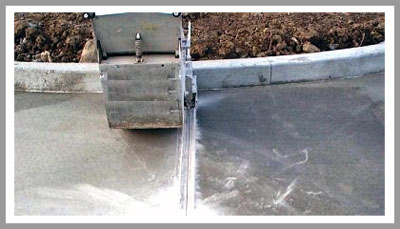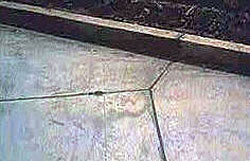Curbs and Gutters
Curbs and Jointing
Advantages | Types | Requirements | Design | AASHTO Standards | Joints | Drainage | Materials | Construction
 Concrete curbs will experience shrinkage, temperature, or moisture changes. They will crack when the built up stresses due to these factors exceed the concrete tensile strength unless adequate measures are taken, for example adequate jointing.
Concrete curbs will experience shrinkage, temperature, or moisture changes. They will crack when the built up stresses due to these factors exceed the concrete tensile strength unless adequate measures are taken, for example adequate jointing.
Good jointing practice will anticipate these cracks and locate them in acceptable locations. When a curb is constructed as part of a pavement, or tied to a pavement, the jointing pattern for the pavement should be carried through the curb. Separate curbs should be jointed at intervals close enough to preclude the formation of intermediate cracks. Some designers prefer to space joints at long intervals and call for reinforcing steel properly located and supported in the concrete to tie the concrete together after it cracks. Including reinforcing steel complicates construction and increases cost. In general, joint spacing will be proportional to the mass of the curb section, and successful local experience should determine joint spacing. Usually contraction joint spacing of fifteen feet (15 ft) is necessary to avoid intermediate cracks in separate curbs.
Whether or not joints should be spaced close enough to control all cracking is a matter of local preference. Small cracks through curbs do not usually reduce the serviceability or attractiveness of curbs, as long as the curbs are uniformly supported.
The depth of contraction joints should be one-fourth of the cross section of the concrete. These joints can be sawed, hand-formed, or formed with thin steel division plates. Sawing must be done as soon as possible without raveling the edges of the joints, before cracks form. Joints can be formed by using jointing tools of the proper shape, or by impressing tee-bars shaped to match the cross section of the curb and gutter. Division plates are placed in the forms and then removed after the concrete has set.
Joints and cracks in concrete curbs do not have to be sealed. The cost would by far exceed any benefits. If a street is maintained with a joint cleaning and sealing program, the longitudinal joint between street and curb apron should be sealed unless the two elements are closely tied together.
 Curbs and concrete sidewalks are sometimes built adjacent to each other in areas of limited right-of-way, in commercial areas, or next to parking lots. Where there are attempts to combine relatively thin sidewalks with heavier curb sections, it is usually best to separate the two elements of different thickness by isolation joints. If they are not separated an effective contraction joint or steel reinforcement should be provided to tie across the locations of anticipated cracks. Where there are safety sidewalks along sides of roadways in tunnels, there is usually structural reinforcing in the curbs and sidewalks to make the normal contraction joints unnecessary.
Curbs and concrete sidewalks are sometimes built adjacent to each other in areas of limited right-of-way, in commercial areas, or next to parking lots. Where there are attempts to combine relatively thin sidewalks with heavier curb sections, it is usually best to separate the two elements of different thickness by isolation joints. If they are not separated an effective contraction joint or steel reinforcement should be provided to tie across the locations of anticipated cracks. Where there are safety sidewalks along sides of roadways in tunnels, there is usually structural reinforcing in the curbs and sidewalks to make the normal contraction joints unnecessary.
Curbs at street intersections and some driveway entrances make sharp curves that affect the ways curbs move. The usual practice is to provide isolation or expansion joints at the tangent points in separate curbs or to locate contraction joints through curbs and pavements where integral curbs are used. Driveway entrances with curved concrete aprons should be separated from adjoining curbs with isolation joints at the tangent points. Isolation joints should also separate ramps for pedestrians at intersection corners from curbs. If isolation joints are needed in unsymmetrical street intersections, the isolation joints should also be carried through abutting curbs. Isolation joints should be formed by single pieces of joint material that extend for the full depths and widths of the joints so that no concrete in the joint spaces interferes with the movement of the concrete on either side. In slipform curbs, the materials can be installed after concrete is removed by sawing or raking partially set concrete to open slots just wide enough for snug fits of jointing materials.


